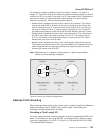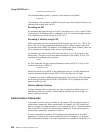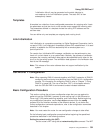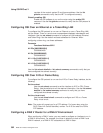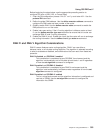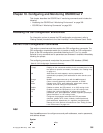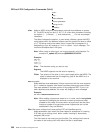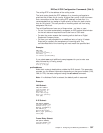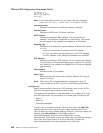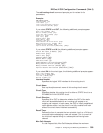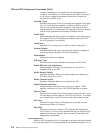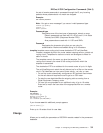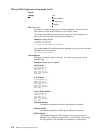
Chapter 10. Configuring and Monitoring OSI/DECnet V
This chapter describes the OSI/DECnet V monitoring commands and includes the
following:
v “Accessing the OSI/DECnet V Monitoring Environment” on page 329
v “OSI/DECnet V Monitoring Commands” on page 329
Accessing the OSI Configuration Environment
For information on how to access the OSI configuration environment, refer to
“Getting Started (Introduction to the User Interface)” in the
Software User’s Guide
.
DECnet V/OSI Configuration Commands
This section summarizes and then explains the OSI configuration commands. The
OSI configuration commands enable you to create or modify an OSI configuration.
Enter all the OSI configuration commands following the OSI Config> prompt.
Defaults for any command and its parameters are enclosed in brackets immediately
following the prompt.
The configuring commands manipulate the permanent OSI database (SRAM).
Table 60. OSI Configuration Commands Summary
Command Function
? (Help) Displays all the commands available for this command level or lists
the options for specific commands (if available). See “Getting Help”
on page xxvi.
Add Adds areas this node supports; receive passwords for
authentication purposes; prefix addresses for other domains; and
aliases
Change Modifies some parameters set up with the add command.
Clear Clears a receive password, transmit password, or SRAM
Delete Deletes areas, PVCs, prefix-addresses, adjacencies, aliases,
subnets, and X.25 routing circuit parameters.
Disable Disables a subnet, the OSI protocol, or an X.25 routing circuit.
Enable Enables a subnet, the OSI protocol, or an X.25 routing circuit.
List Displays the current configuration of adjacencies, aliases,
passwords, pvcs, prefix-addresses, subnets, algorithm, phaseivpfx,
global information, or X.25 routing circuits.
Set Configures the properties associated with OSI parameters
(switches, globals, NETs, timers, subnets, transmit-password,
prefix-addresses, adjacencies, pvc, algorithm, and phaseivpfx)
Exit Returns you to the previous command level. See “Exiting a Lower
Level Environment” on page xxvii.
Add
Use the add command to configure area and prefix addresses, receive passwords,
and address aliases.
Syntax:
add
alias
© Copyright IBM Corp. 1994, 1998 305



